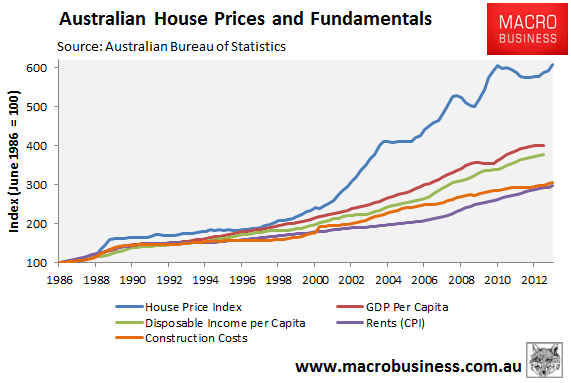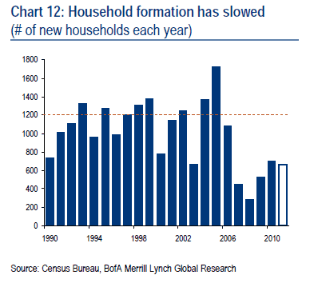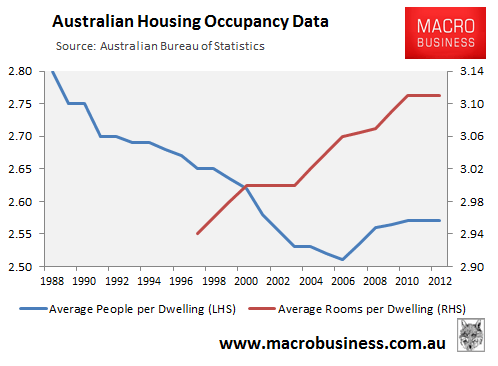
Alan Kohler has posted an interesting article in The Australian today arguing that Australian housing is not a bubble, since values are underpinned by a shortage of homes (my emphasis):
INVESTING in property is a no-brainer at the moment. Prices have bottomed, auction clearance rates are on fire, especially in Sydney, and you can get a fixed rate mortgage for 4.8 per cent with 100 per cent gearing, 70 per cent in your super fund.
And the experts are now saying there’ll be another housing bubble. What could be better?…
The main problem with houses in Australia is that we never build enough of them, and the main problem with the Australian economy is not housing — it’s that it’s begun a transition from resource investment-led growth to . . . well, hopefully something else.
In the US between 2002 and 2007 low interest rates led to a boom in both house prices and house building. They ended up with a glut of houses and prices collapsed: you could famously buy a house for the price of a second-hand car.
In Australia over the same period there was a house price boom and that’s it — no glut. In fact there has been a consistent shortage of housing in this country right through the boom and bust of at least 100,000 per annum. As a result, prices didn’t fall much and have started rising earlier than in the US…
So Australia has a housing supply-side problem that means the definition of a price bubble is distorted. Bubbles only occur when supply exceeds demand. Just because a price rises a lot, that doesn’t mean it’s a bubble if there’s a shortage.
While I strongly agree with Kohler that Australia does have a land/housing supply problem, I disagree with his assertion that there could be no bubble.
Basic economics tells us that policies that restrict housing supply steepens the supply curve, which makes house prices far more sensitive to changes in demand and increases the likelihood of the housing market experiencing boom/bust price cycles as demand rises/falls.
This is a topic that I have written about many times before, for example here and here. It is also a view supported by research. For example, a recent Journal of Urban Economics paper by Haifang Huanga and Yao Tang suggests the link between higher house price volatility and non-responsive housing supply (e.g. due to restrictive land use regulations) has become more pronounced in the US [my emphasis]:
Abstract: “In a sample covering more than 300 cities in the US from January 2000 to July 2009, we find that more restrictive residential land use regulations and geographic land constraints are linked to larger booms and busts in housing prices. The natural and man-made constraints also amplify price responses to the subprime mortgage credit expansion during the decade, leading to greater price increases in the boom and subsequently bigger losses.
And in a detailed examination of studies in this area, Harvard’s Edward Glaeser and Warton’s Joseph Gyourko also concluded that tight land/housing supply leads to greater price booms and busts:
Recent research also indicates that house prices are more volatile, not just higher, in tightly regulated markets …. price bubbles are more likely to form in tightly regulated places, because the inelastic supply conditions that are created in part from strict local land-use regulation are an important factor in supporting ever larger price increases whenever demand is increasing.
…. It is more difficult for house prices to become too disconnected from their fundamental production costs in lightly regulated markets because significant new supply quickly dampens prices, thereby busting any illusions market participants might have about the potential for ever larger price increases.
Indeed, an examination of house prices against GDP growth, income growth, rents, and construction costs suggests that Australian housing has become disconnected from fundamental value (see next chart).

And while this does not mean that a significant correction is imminent – if anything house prices are set to rise over the near term – the overvaluation does heighten risks of a disorderly unwind in the event that demand were to suddenly fall, say via a combination of: a steep fall in commodity prices; a sharper than expected contraction in mining investment; a significant rise in unemployment; or a global liquidity squeeze.
Another interesting aspect of the US housing market is that underlying demand was running strong in the years leading-up to the bust. Unemployment was low, the US economy was motoring along, credit was readily available, and a record 1.7 million households were formed in 2005 – 500,000 more than the long-run average of 1.2 million household formations per year.
The surge in household formations led to numerous suggestions that the US was facing a housing shortgage, especially in areas where strict land-use regulations were in effect, such as California.
The rest is history. The US housing bubble popped, the economy tanked, and the rate of household formation fell to around half the long-run average (see below chart), leaving a vast oversupply of homes, even in severely supply-restricted markets like coastal California.

The key lesson from the US experience is that the demand for housing is highly changeable depending, largely, on prevailing economic conditions. And while Australia is in some respects fortunate that it has not experienced the types of over-building experienced in some other nations, it could equally be argued that there is significant latent capacity (excess bedrooms) in the pre-existing housing stock versus persons per dwelling (see below chart).

Should economic conditions deteriorate significantly, such as via a disorderly unwinding of the mining boom, the number of Australians opting for group accommodation (or the number of young people moving back into mum and dad’s) could rise significantly, turning a perceived housing shortage into a surplus.

